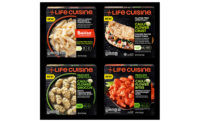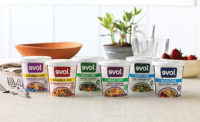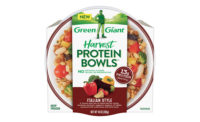CONVENIENCE MEALS: Entrees Take the Orient Express

Consumers have a wide array of frozen dinner options, including meal kits and bowl meals. The increasing availability and variety of ethnic entrées adds excitement to dining at home. Last year, ethnic frozen entrées reached sales of $2.2 billion (ACNielsen 9/30/00).
Formulating Asian-inspired entrées for American palates involves tweaking authentic recipes for American tastes. On the other hand, as Americans travel about the globe, their palates are becoming more educated, and they can appreciate the nuances of true Asian cuisine.
Still, food manufacturers say combining components into Asian-inspired entrées is a challenge.
From Restaurant to Mass Market
Several food manufacturers have created frozen entrées based on items carried on their restaurant menus. Two such manufacturers include King's Hawaiian, Torrance, Calif. and Kahiki Foods, Inc., Columbus, Ohio.Restaurants are excellent testing grounds for introductions, says Shelby Weeda, executive vice president of King's Hawaiian. "We moved our most popular dishes from the menu into production. We ask consumers for feedback about our menu items. Watching the plates come back, we observe what portions of the meal are left and make recipe adjustments accordingly."
Almost nine years ago, King's Hawaiian launched teriyaki chicken entrée bowls in club stores. One initially rejected the first two versions, prepared with dark meat chicken, steamed vegetables and white rice, in an authentic Asian style. On the third try, the store approved the reformulated entrée with upgraded vegetables, im-proved sauce, roasted chicken tenderloins, and rice pilaf (suited to Americans).
"The secret to our success is premium ingredients," says Weeda. King's entrées include white meat chicken tenderloins--the most expensive, tender part of the chicken located just under the breast--its own sauces, premium-cut vegetables and rice pilaf.
"We use high-viscosity sauces to enrobe the chicken during the microwave process," says Weeda. "Upgraded vegetables include red and green bell peppers, onions, broccoli florets and yellow carrots. We added more onions to the rice pilaf and a bit more flavoring." The vegetables are individually quick frozen (IQF), and many are julienne sliced to enhance quality. The chicken is marinated in a vacuum tumbler.
While teriyaki is one of the most popular Asian flavors in this country (see sidebar), such is not the case for Kahiki Foods. Sesame Orange Chicken leads in sales, followed by Beef & Broccoli and Chicken Fried Rice.
"Our goal is authentic Asian or Pacific Rim products easy to prepare," says Alan Hoover, senior vp, sales and marketing, Kahiki Foods. "We do not necessarily gear products for the mass market. Consumers are realizing the difference between authentic ethnic products and Americanized versions."
Signature Sauces
While many frozen food manufacturers rely on a supplier to provide sauces, such as teriyaki, some prefer to make their own "signature" sauces to set themselves apart from the competition. "Most manufacturers can assemble rice and vegetables, but only a few can make noteworthy sauces," says Weeda.During a slow cooking process, the ingredients in King's Hawaiian sauces blend, and flavors are formed during cooking. King's sauces are more viscous than typical thin Japanese-style sauces. While Americans prefer their sauces to cling to the items they are coating, Japanese prefer thin sauces, such as soy sauce.
"A challenge in formulating our own sauces is adding the right types and levels of gums and starches," says Weeda. "Our goal is a high-viscosity sauce not too gummy tasting and that does not clump during microwave cooking. The sauce should stay on top of the entrée ingredients and not run to the bottom of the bowl."
Signature sauces generally begin with a chef's recipe, notes John Bauman, vp, culinary business unit, Wild Flavors, Inc., Erlanger, Ky. "Often, a customer produces a sauce on a small scale and wants us to commercialize it. This means turning a recipe into a formula to be made in a manufacturing facility--using flavorings, freeze-thaw stable starches and other ingredients to withstand the rigors of processing."
Rectifying Rice
Although noodles are also used in Oriental-style entrées, rice is by far the most popular carbohydrate source. Some segments of the Asian population prefer short grain sticky white rice, but rice consumers in other parts of the world--such as the U.S.--prefer long grain white rice or other less sticky types. The ratio of the two starches, amylose to amylopectin, accounts for the stickiness of short grain rice. In general, the lower the amylose content and the higher the amylopectin level, the stickier the rice.Some manufacturers, such as Kahiki Foods, use a blend of long and short grain rice in their frozen entrées. This helps avoid stickiness problems during manufacturing.
Parboiled long grain rice is the most popular option for frozen entrée manufacturers. Parboiled rice has been subjected to a steam-pressure treatment to gelatinize starch within the rice kernel before milling. This results in firmer, more separate grains better able to withstand processing rigors than regular-milled white rice. However, most authentic Oriental entrées would not use par-boiled rice.
Another option for frozen entrées is IQF rice. Cooked rice grains are individually frozen before packaging to make them more free flowing. IQF rice is often used when a processor does not have the equipment to cook rice. However, most food processors cook their own rice for economic reasons.
"Rice is commonly cooked to about 10% less moisture than for stovetop cooking," says Dean Oliver, pilot plant coordinator, Riceland Foods, Stuttgart, Ark. "Undercooking rice compensates for abuse through freezing and thawing to avoid a soggy texture."
Flavorful Options
Fresh ingredients may have a certain cachet among chefs and other culinary specialists, but combinations of flavorings, spices and seasonings can be used to create tasty entrées."Flavorings offer consistency of supply both in flavor and in quality," says Bauman, "and also offer ease of handling and longer shelf life over fresh agricultural ingredients. Flavor profiles can be adjusted to consumer needs. Adjusting concentration levels and usage levels of flavorings can make these more cost effective."
Flavors can also be used to help mask defects in meat products, including warmed-over flavor due to lipid oxidation in pre-cooked meat. "Using a combination of flavor technology to mask flavor defects and high-quality flavors, such as reaction flavors that withstand freeze-thaw conditions, food processors can obtain optimum flavor profiles in frozen entrées," says Bauman.
While reaction-based flavors, such as meat and sesame, survive processing conditions well, more volatile flavors do not and should be added at the end of the heating process.
One flavor challenge in developing more authentic Asian meals is the heat level in spicy entrées such as Szechwan and General Tso's Chicken. "It can be tough deciding what levels of heat to use in our products," says Hoover. "A few warehouse club and retail customers have said our products are too hot for the masses, so we toned the sauce down a bit without compromising on the overall formulation." One option could be to include a hot spice packet with the entrée for those consumers who prefer greater heat intensity.
Kahiki Foods previously produced a spicy Kung Pao Chicken and Thai Chicken; however, both products were discontinued due to poor sales.
"These products were perceived as spicier and more exotic, putting them on the edge for frozen entrées," says Hoover. "We may bring them back in a few years to see if people are ready for these spicier foods. We believe consumers are becoming more adventuresome in their eating."
|
Looking for a reprint of this article?
From high-res PDFs to custom plaques, order your copy today!








